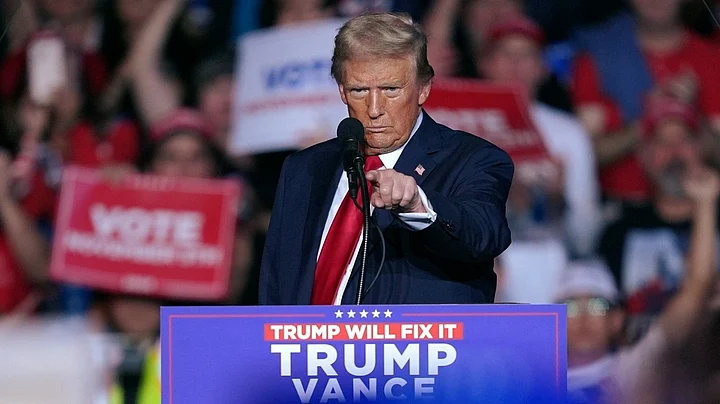President Biden seems to be working along a very carefully crafted policy in allowing Ukraine to use the ATACM (Army Tactical Missile) system, made and supplied by the US, in the ongoing Russia-Ukraine war.
Firstly, he has, most importantly, limited his permission for use to the Kursk region, where the Ukrainians hold a chunk of Russian territory. This is an effort to help Ukrainian forces in the region who are confronting some 50,000 Russian and North Korean troops deployed for a counter-offensive.
Secondly, his move seems to be calibrated with the arrival of the new Trump administration on 20 January next year. It is well known that Trump has a different view of the war and of American military aid to Ukraine. He has declared his intention of bringing it to a close as early as he can.
Third, Biden's move seemed to be aimed as much at North Korea as at Russia. By supplying artillery and ammunition supplies, as well as deploying anywhere up to 10,000 troops in Kursk, the North Koreans are shifting the geopolitical dynamics of the Ukraine war, alarming the US and NATO.
The goal of the ATACM strategy, therefore, seems to be to enable Ukraine to hold on to Kursk as a bargaining chip in the likelihood that the Trump administration will call for a ceasefire and negotiations.
The Biden administration has not publicly confirmed the policy shift. On Monday, the State Department spokesman only said that the US response to Russian-North Korean military cooperation “would be firm.”
On Tuesday, Ukraine carried out its first strike on a border region of Russia with an ATACM system, according to Ukrainian media reports. No details were provided of the exact area or the target.
Why is the ATACM System Important?
The ATACM system is a highly accurate surface-to-surface ballistic missile capable of hitting targets up to 300 km. Ukraine already has the missiles but has been using them heretofore on targets in Ukrainian territory occupied by Russia.
The system can be configured to carry two kinds of warheads. The first is a cluster system with hundreds of bomblets designed to strike lighter armoured vehicles, aircraft, air defence systems, and troop concentrations within a wide area. The second type of a warhead is a 225 kg bomb which can destroy hardened facilities and larger structures.
The Ukrainians occupy just about 1000-1500 sq km of the Kursk region. While this area provides a buffer zone to protect Kharkiv against Russian shelling and attacks, it has also forced the Russians to divert some forces to defend incursions into their territory.
It has also provided Ukraine with a propaganda victory in declaring that it too has been able to make inroads into Russia, raising the morale of the Ukrainian forces who have otherwise been facing a grim onslaught from the other side.
Now, with the possibility of a ceasefire and negotiations being forced on them by the new American administration, the main value of the Kursk incursion is the leverage it will provide Kyiv in its negotiations with Moscow.
Still, this will be limited because Russia occupies 20 percent of Ukraine’s territory — roughly about 70,000 sq km in the eastern Luhansk and Donetsk regions and in the southern Zaporizhzhia, Kherson, and the Crimean peninsula that it occupied in 2014.
The Americans might enlarge the area in which the ATACMS can be used depending on the evolving situation. But its initial use is permitted only in Kursk where the Russian/North Korean offensive is expected. It will be used to target military bases, infrastructure, and ammunition storage depots. Russia has already moved its fighter aircraft to airfields deeper in the country in anticipation of an attack.
Russia's Response
The use of the missile is not likely to be decisive as the Ukrainians have only a limited stock, and it cannot turn the tide of the war which is otherwise going badly for Kyiv, especially in the east.
It can also have the effect of having the UK and France give Ukraine permission to use their Storm Shadow missiles inside Russia. This is a long-range cruise missile also in use by the Ukrainians and has capabilities similar to the ATACMS.
The Russian response to the move has been harsh.
On Monday, their foreign ministry spokesman said that the use of long-range missiles by Ukraine would lead to “an appropriate and tangible” response. It said that an attack inside Russian territory “would represent the direct involvement of the United States and its satellites in hostilities against Russia.”
On Tuesday, President Putin chose to sign a decree making official a September 2024 announcement that changed the Russian nuclear doctrine.
The new doctrine allows the use of nuclear weapons in the event of a “massive launch” of air strikes against Russia as well as an attack by a non-nuclear country backed by a nuclear-armed power.
The Ukrainians have not been happy with the restrictions that the US has been putting on them and the slow supply. Many say that Biden decision's is a case of being too little and too late.
The Russians have in the past, threatened to use nuclear weapons in Ukraine. Just how the current situation develops is difficult to forecast. But there is little doubt that the Ukraine-Russia war has taken a dangerous and possibly destabilising turn in the last few days.
(The writer is a Distinguished Fellow, Observer Research Foundation, New Delhi. This is an opinion article and the views expressed above are the author’s own. The Quint neither endorses nor is responsible for them.)
(At The Quint, we question everything. Play an active role in shaping our journalism by becoming a member today.)



